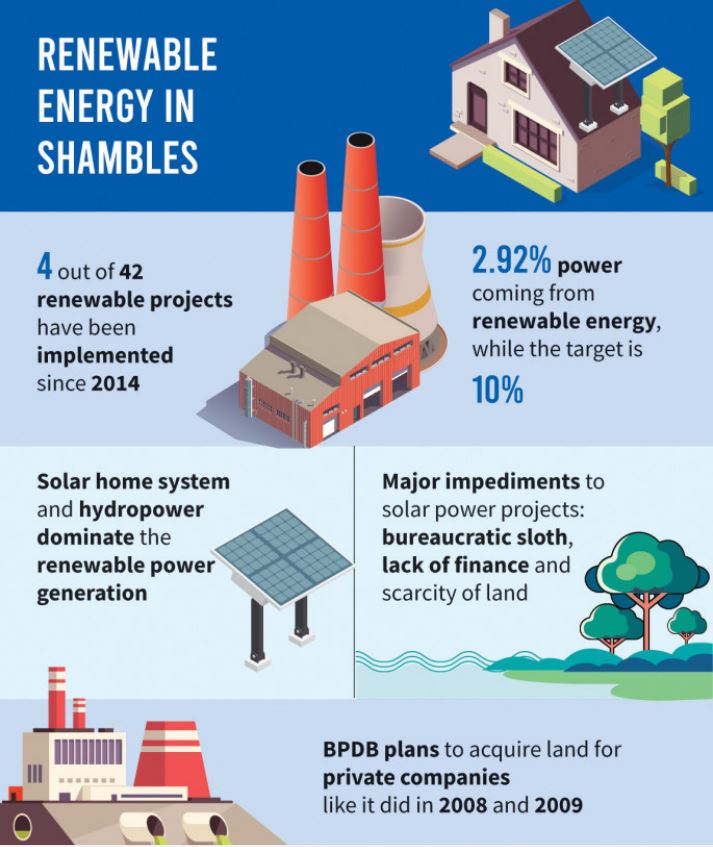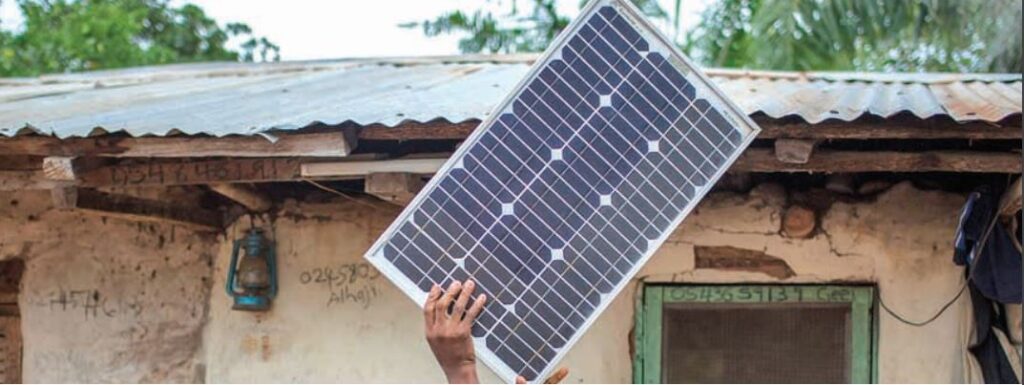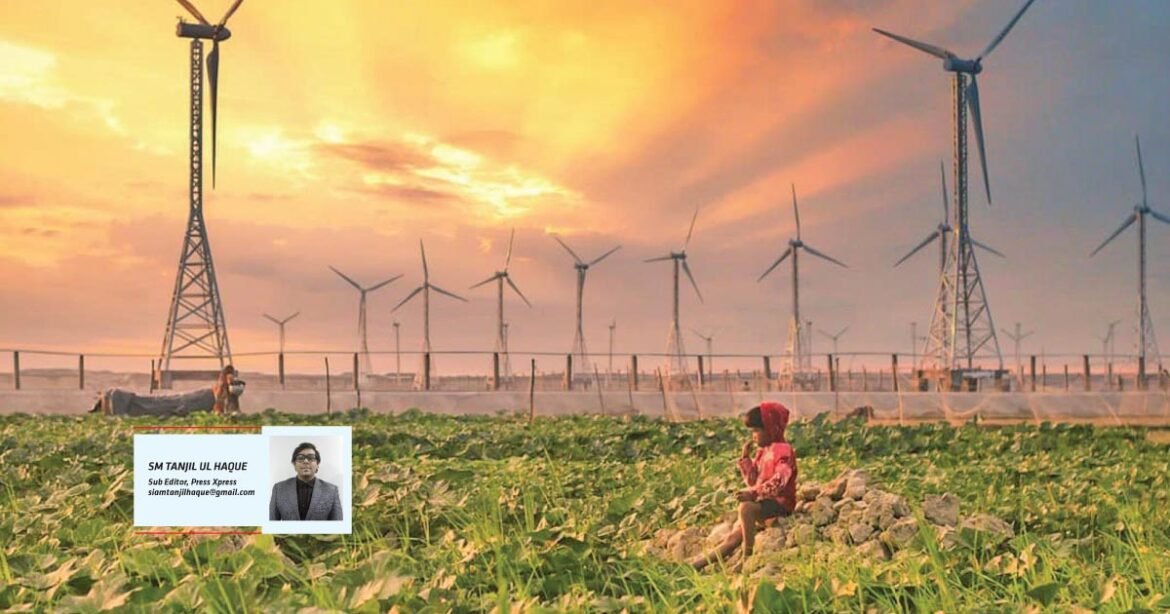Bangladesh is making progress towards utilising renewable energy sources such as solar, wind, and hydro power, with a target of generating 40 percent of its energy from renewables by 2041. The use of renewable energy sources has the potential to significantly boost the country’s economic growth, generate jobs, and reduce dependence on imported fossil fuels. However, there are some challenges that need to be addressed in order to achieve this goal, Writes SM TANJIL UL HAQUE.
As the world grapples with the current global energy crisis, there is an increasing urgency to shift towards renewable and sustainable energy sources, not only to mitigate the risks of energy insecurity but also to curb the adverse environmental impacts of fossil fuels. Bangladesh, a developing country in South Asia, not long ago, faced an energy crisis due to the shortage of traditional energy sources. Despite this challenge, the country has made remarkable strides towards utilizing renewable energy sources, which hold great potential for its economic growth. Renewable energy sources include solar, wind, and biomass, which are the most viable options for Bangladesh. However, the utilization of biomass must be carefully managed, considering the high demand for agricultural and animal waste for cooking in rural areas and the risk of soil degradation. As a result, it is crucial to examine the current state of renewable energy in Bangladesh and its potential to fuel the country’s economic development. The need to shift to renewable and sustainable energy sources is now more pressing than ever, considering the global energy crisis and the limited extraction and consumption of natural resources.
You can also read: Biden calls Bangladesh’s 50 years of economic growth a “remarkable story”
THE CURRENT STATE OF RENEWABLE ENERGY
According to the Bangladesh Power Development Board (BPDB), only 65% of the population has access to electricity, and the country heavily relies on fossil fuels for electricity production. However, in recent years, Bangladesh has made significant progress in promoting renewable energy sources. Currently, renewable energy contributes to only 3% of the country’s total electricity generation, but the government aims to increase this to 20% by 2025. Moreover, Bangladesh heavily relies on fossil fuels for electricity production, with only 65% of the population having access to electricity. In recent years, the government has been making progress in promoting renewable energy sources with a target of increasing renewable energy’s contribution to 20% by 2025. The country’s rise to one of the top global economies is fascinating but comes with the cost of an increased standard of living, and it has the fifth-largest number of internet users in the Asia-Pacific.

Bangladesh has set a target of generating 40% of its energy from renewable sources by 2041 and has proposed around 41 gigawatts of solar generation in the same timeframe. However, despite progress in renewable energy, the country still relies heavily on natural gas, coal, liquefied natural gas (LNG), and nuclear energy sources. Bangladesh has cancelled ten coal-based power facilities worth $12 billion in foreign investment and currently has two coal-fired power plants in operation, seven under construction, and a 1,200 MW nuclear power plant expected to go online by 2025. Additionally, there are eight small-scale gas and LNG plants under construction, and five large-scale natural gas plants are in the planning phase. With all these new projects in the works, Bangladesh is on track to have around 40,000 MW installed capacity by 2030, highlighting the importance of shifting toward green energy.
SOLAR POWER
One of the most promising renewable energy sources in Bangladesh is solar power. The country’s geographic location makes it an ideal location for solar energy, with an average of 5.5 hours of sunshine per day. Bangladesh has made significant progress in promoting solar energy through various government initiatives, including the Solar Home System (SHS) program, which has provided access to electricity to more than 5 million rural households. The government has set a target of installing 1.5 million SHS by 2021.
WIND POWER
Another renewable energy source that Bangladesh is exploring is wind power. The country has the potential to generate 20,000 MW of electricity from wind power, according to the Ministry of Power, Energy and Mineral Resources. The government has set a target of generating 10% of the country’s electricity from wind power by 2030.
HYDRO POWER
Bangladesh is also exploring the potential of hydro power. The country has several rivers and waterfalls, which can be used for generating electricity. The government has identified several potential sites for hydro power projects, and feasibility studies are currently underway.

THE POTENTIAL FOR ECONOMIC GROWTH
The use of renewable energy sources in Bangladesh has the potential to boost the country’s economic growth significantly. According to a study by the International Renewable Energy Agency (IRENA), the use of renewable energy could generate over 1 million jobs in Bangladesh by 2050. Moreover, the country could save up to $2.5 billion annually by reducing its reliance on imported fossil fuels.
Investment in renewable energy could also attract foreign investment and create new business opportunities. According to a report by the United Nations Development Program (UNDP), investing in renewable energy in Bangladesh could generate up to $19 billion in revenue by 2030. However, the potential for economic growth through the adoption of renewable energy sources in Bangladesh cannot be overstated. According to the International Renewable Energy Agency (IRENA), the use of renewable energy has the potential to create more than 1 million jobs in Bangladesh by 2050.
Additionally, the country could save up to $2.5 billion annually by reducing its dependence on imported fossil fuels. Moreover, investing in renewable energy could attract foreign investment, create new business opportunities, and generate up to $19 billion in revenue by 2030, as suggested by a report from the United Nations Development Program (UNDP).
These benefits highlight the importance of discussing the current state of renewable energy in Bangladesh and the opportunities it presents for future economic growth.

BOOSTING RENEWABLE ENERGY MUST TO KEEP UP WITH GLOBAL PROGRESS
In recent years, renewable energy has seen a surge in popularity, with developing countries leading the charge. For example, in 2021, solar PV capacity grew by 175 GW globally, with China adding the highest annual amount of solar power capacity, and India increasing its installed solar capacity to 64 GW. Bangladesh, however, is lagging behind with only 3% of its power coming from renewable sources. This figure is unsustainable, given the expected growth in energy needs and the inadequacy of natural gas reserves. Although the government has taken positive steps such as cancelling 10 coal power plants and setting a goal of 40% clean energy by 2041, actual targets for attaining renewables remain vague. Bangladesh could generate more than 20,000 MW of solar power by setting up solar panels in industrial rooftops and unused land, while wind power has started to be explored with two projects currently underway. Better storage technology and more policy attention to this area could address the limited availability of sunlight for a few hours of the day. If Bangladesh does not boost its renewable energy sector, it risks falling behind other countries in terms of sustainability and economic growth.
ACHIEVING THE RENEWABLE ENERGY DREAM
Bangladesh has ambitious plans to shift towards sustainable energy, but its current energy consumption from clean sources is only 3.5%. This is in contrast to other economies, where the annual share of electricity generated from renewables exceeded 40%. According to the Bangladesh Power Division, the country is on track to have around 40,000 MW installed capacity by 2030. However, with many large-scale non-renewable power projects also in the works, it is highly important for Bangladesh to shift towards green energy.
To achieve its target, the government recently launched projects that include a 500 MW solar farm, a 1 MW biomass plant, and four wind farms. Harvesting renewable energy from the Bay of Bengal is crucial for Bangladesh to achieve its dream of renewable energy contributing 40% to the national grid.
Technologies to extract energy from waves and tides have great potential, but currently, bottomfixed offshore wind represents the largest part of renewable energy production from the ocean. The International Energy Agency estimates that offshore wind could generate 18 times the world’s current electricity demand.

CHALLENGES AND SOLUTIONS
Despite the potential for economic growth, there are several challenges that Bangladesh must overcome to promote renewable energy. One of the most significant challenges is the high initial cost of renewable energy infrastructure. The government is taking steps to address this by offering incentives such as tax breaks and subsidies to encourage investment in renewable energy.
Another challenge is the lack of technical expertise and infrastructure. The government is addressing this by investing in training programs and partnering with international organizations to develop the necessary infrastructure. Furthermore, the intermittent nature of renewable energy sources such as wind and solar power presents a challenge for energy storage and grid management. The Bangladesh government is exploring the use of energy storage solutions, such as batteries and pumped hydro storage, to ensure a stable and reliable power supply. The government is also investing in modernizing the country’s electricity grid infrastructure to better integrate renewable energy sources and improve energy efficiency. These efforts will not only help overcome the challenges of intermittency but will also enhance the resilience and reliability of Bangladesh’s electricity system. Moreover, promoting public awareness about renewable energy and its benefits can play a crucial role in overcoming the challenges and promoting a renewable energy powered nation. By addressing these challenges and implementing effective solutions, Bangladesh can achieve its goal of becoming a leader in sustainable and renewable energy.
To conclude, the technological evolution of renewable energy sources in Bangladesh shows great potential for future economic growth. The government’s commitment to promoting renewable energy and the potential for job creation and revenue generation makes it a promising investment opportunity. However, there are challenges that must be overcome, such as the high initial cost and the lack of technical expertise. The government’s efforts to address these challenges through incentives and partnerships are encouraging, and with continued investment in renewable energy, Bangladesh can achieve its goal of becoming a sustainable, renewable energy-powered nation.


